
When we created the Mushroom Alliance years ago when we recognized the need customers to more about their mushrooms. Especially, where the mushrooms were grown, how they were produced, and how they are handled from the farm to their plate.
The most important goal of ours is the safety of our customers and their family, by making sure that we are providing them with mushrooms of the highest of quality.
Food to PlateCertificationsThe most important job on the farm is to ensure that food is produced in a safe manner. The food chain consists of a series of steps, beginning with planting and growing through to harvesting, processing, transport and storage, and finally, sale to the consumer.




Bacteria prevention is making sure that if chemicals are used in raising the crops, there isn't enough left on the produce to cause harm to health or that there is an absence of microorganisms and their toxins in amounts that may cause illness. We accomplish this by using chemicals very sparingly and always in accordance with label directions. Most of the time, we will use some other methods to keep pests out like making sure that doors close tightly and that there are screens over any open areas instead of applying chemicals. Prevention of harmful bacteria is accomplished by following Good Agricultural practices. This means that workers wear clean clothing, wash their hands often and make sure they don't transfer harmful bacteria from other areas onto the mushrooms.
Some of our mushrooms are direct pick and do need to be further processed, but others are sent to processing to be sliced or repackaged. Food safety in a processing plant involves eliminating and/or preventing the growth of bacteria that exist in all food and which could cause food borne illness. We accomplish this with a robust sanitation program. All equipment and areas within our processing center are thoroughly cleaned every day by a crew that is trained specifically for the job. All workers in the plant follow Good Manufacturing Practices while working.
The next area is transport and storage of the food. At this step, the main concerns for fresh produce is to maintain the proper temperature and to keep accurate records so that if there are any issues with food safety, the product can be traced back to the fields or trays in which it was grown or traced to the stores and warehouses where it will be shipped.
The last step is when the food reaches the consumer. So far there has been many people involved in making sure that the food is safe when it gets to
this point, but what happens from the time it comes home from the store until it ends up on the dinner plate is still important. Studies show that there are only a few things that seem to cause the majority of the problems at this point. These include preparing food long before it is going to be eaten, leaving prepared food too long at a temperature that will allow bacteria to grow, not adequately heating food meant to be served hot, and contaminating the food through handling. An example of this is using the same knife and cutting board for raw meat and fresh produce.
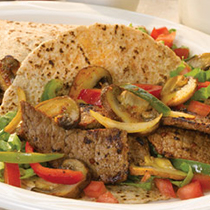
Spice it up while keeping your family’s plate balanced with this recipe. It doesn't take long to make and it is easy to create.
TOTAL TIME: Prep/Total Time: 30 min.

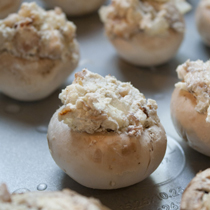
Perfect choice if your having a large crowd over for dinner or even just for the family. Also, who doesn't enjoy bacon?
TOTAL TIME: Prep/Total Time: 20 min.

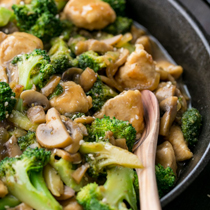
A perfect and healthy choice for your mushroom loving family. That utilizes organic ingredients, that is better than takeout!
TOTAL TIME: Prep/Total Time: 30 min.
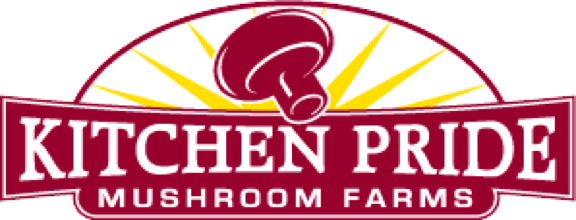
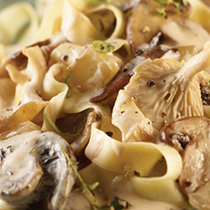
Don't let the name fool you, you can use any of alliance members mushrooms. This will easily become a family favorite.
TOTAL TIME: Prep/Total Time: 40 min.

Spice it up while keeping your family’s plate balanced with this recipe. It doesn't take long to make and it is easy to create.
TOTAL TIME: Prep/Total Time: 30 min.

-12 oz sirloin or other boneless steak, about ¾-inch thick
-1 tablespoon no-salt fiesta lime seasonsing, divided
-1 tablespoon olive oil
-3 cups sliced crimini mushrooms
-1 mediuym green bell pepper, sliced into strips
-1 medium red bell pepper, sliced into strips
-1 medium yellow or white onion, sliced into strips
-8- 6-inch whole wheat tortillas
-1 medium tomato, diced
-2 cups shredded iceberg lettuce
-4 tablespoons non-fat sour cream
Soak dried mushrooms in boiling-hot water in a bowl until softened, about 20 minutes. Drain in a paper-towel-lined sieve set over a bowl and reserve soaking liquid, then rinse soaked mushrooms. Pat dry and finely chop.
Heat 3 tablespoons butter in a 12-inch heavy skillet over moderately high heat until foam subsides, then sauté fresh mushrooms with garlic, salt, and pepper, stirring occasionally, until liquid mushrooms give off is evaporated and mushrooms are browned, 5 to 7 minutes. Stir in chopped soaked mushrooms and reserved mushroom-soaking liquid and simmer 1 minute, then remove from heat.
Cook pasta in a 6- to 8-quart pot of boiling salted water until al dente, about 5 minutes. Ladle out and reserve 1/4 cup pasta cooking water. Drain pasta in a colander, then add it to mushrooms in skillet. Add remaining 2 tablespoons butter and cook over moderately high heat, tossing and adding some pasta-cooking liquid if necessary to lightly coat, 1 minute. Add chives, parsley, lemon zest, and juice, then toss well. Serve immediately with cheese and pepper to taste.
Perfect choice if your having a large crowd over for dinner or even just for the family. Also, who doesn't enjoy bacon?
TOTAL TIME: Prep/Total Time: 20 min.

-1 package (8 ounces) cream cheese, softened
-1/2 cup real bacon bits
-1 tablespoon chopped green onion
-1/4 teaspoon garlic powder
-1 pound whole fresh mushrooms, stems removed
In a small bowl, beat cream cheese until smooth. Stir in the bacon, onion and garlic powder. Spoon into mushroom caps. Broil 4-6 in. from the heat for 4-6 minutes or until heated through. Serve warm.
A perfect and healthy choice for your mushroom loving family. That utilizes organic ingredients, that is better than takeout!
TOTAL TIME: Prep/Total Time: 30 min.

-1 lb boneless skinless chicken breast, cut into ¾" pieces
-¼ cup all-purpose flour1 cup chicken broth/stock
-¼ cup honey
-¼ cup soy sauce
-½ Tbsp fresh ginger, peeled and grated (*see note)
-2 medium garlic cloves, grated
-2 tsp sesame oil, optional but recommended
-2 Tbsp cooking oil (I used extra light olive oil), divided
-1¼ lb broccoli (about 6 cups broccoli florets)
-1 small onion, sliced
-¾ lb (12 oz) white button mushrooms, sliced
Trim chicken breast of any excess fat and pat dry with paper towels. In a medium bowl, toss chicken breast with ¼ cup flour until evenly coated. Remove chicken to a plate (leave remaining flour in the bowl - you'll use it for the sauce)
To make the sauce: in the bowl with remaining flour, add 1 cup chicken stock, ¼ cup honey, ¼ cup soy sauce, ½ Tbsp grated ginger, 2 cloves grated garlic and 2 tsp sesame oil (if using) and stir until smooth. Set aside.
Heat a wok or large heavy-bottomed skillet on medium high heat and add 1 Tbsp olive oil. Once oil is hot, add chicken pieces and spread out evenly. Let chicken sit for a minute before stirring, then stir fry 5 minutes or until browned. Remove chicken from the pan and set aside.
Add another 1 Tbsp of oil to the same pan. Once oil is hot, add small broccoli florets, onions and sliced mushrooms to the pan and stir-fry 4 minutes, or until mushrooms are softened and broccoli is crisp-tender.
Stir the sauce again then pour it your hot vegetables. Bring to a boil over medium heat, stirring constantly. Simmer 2 minutes or until sauce is thickened then toss in chicken and cook another 30 seconds or until heated through. Season to taste with salt if needed and serve over hot rice.
Don't let the name fool you, you can use any of alliance members mushrooms. This will easily become a family favorite.
TOTAL TIME: Prep/Total Time: 40 min.

-12 oz sirloin or other boneless steak, about ¾-inch thick
-1 tablespoon no-salt fiesta lime seasonsing, divided
-1 tablespoon olive oil
-3 cups sliced crimini mushrooms
-1 mediuym green bell pepper, sliced into strips
-1 medium red bell pepper, sliced into strips
-1 medium yellow or white onion, sliced into strips
-8- 6-inch whole wheat tortillas
-1 medium tomato, diced
-2 cups shredded iceberg lettuce
-4 tablespoons non-fat sour cream
Soak dried mushrooms in boiling-hot water in a bowl until softened, about 20 minutes. Drain in a paper-towel-lined sieve set over a bowl and reserve soaking liquid, then rinse soaked mushrooms. Pat dry and finely chop.
Heat 3 tablespoons butter in a 12-inch heavy skillet over moderately high heat until foam subsides, then sauté fresh mushrooms with garlic, salt, and pepper, stirring occasionally, until liquid mushrooms give off is evaporated and mushrooms are browned, 5 to 7 minutes. Stir in chopped soaked mushrooms and reserved mushroom-soaking liquid and simmer 1 minute, then remove from heat.
Cook pasta in a 6- to 8-quart pot of boiling salted water until al dente, about 5 minutes. Ladle out and reserve 1/4 cup pasta cooking water. Drain pasta in a colander, then add it to mushrooms in skillet. Add remaining 2 tablespoons butter and cook over moderately high heat, tossing and adding some pasta-cooking liquid if necessary to lightly coat, 1 minute. Add chives, parsley, lemon zest, and juice, then toss well. Serve immediately with cheese and pepper to taste.
-12 oz sirloin or other boneless steak, about ¾-inch thick
-1 tablespoon no-salt fiesta lime seasonsing, divided
-1 tablespoon olive oil
-3 cups sliced crimini mushrooms
-1 mediuym green bell pepper, sliced into strips
-1 medium red bell pepper, sliced into strips
-1 medium yellow or white onion, sliced into strips
-8- 6-inch whole wheat tortillas
-1 medium tomato, diced
-2 cups shredded iceberg lettuce
-4 tablespoons non-fat sour cream
Soak dried mushrooms in boiling-hot water in a bowl until softened, about 20 minutes. Drain in a paper-towel-lined sieve set over a bowl and reserve soaking liquid, then rinse soaked mushrooms. Pat dry and finely chop.
Heat 3 tablespoons butter in a 12-inch heavy skillet over moderately high heat until foam subsides, then sauté fresh mushrooms with garlic, salt, and pepper, stirring occasionally, until liquid mushrooms give off is evaporated and mushrooms are browned, 5 to 7 minutes. Stir in chopped soaked mushrooms and reserved mushroom-soaking liquid and simmer 1 minute, then remove from heat.
Cook pasta in a 6- to 8-quart pot of boiling salted water until al dente, about 5 minutes. Ladle out and reserve 1/4 cup pasta cooking water. Drain pasta in a colander, then add it to mushrooms in skillet. Add remaining 2 tablespoons butter and cook over moderately high heat, tossing and adding some pasta-cooking liquid if necessary to lightly coat, 1 minute. Add chives, parsley, lemon zest, and juice, then toss well. Serve immediately with cheese and pepper to taste.
-1 package (8 ounces) cream cheese, softened
-1/2 cup real bacon bits
-1 tablespoon chopped green onion
-1/4 teaspoon garlic powder
-1 pound whole fresh mushrooms, stems removed
In a small bowl, beat cream cheese until smooth. Stir in the bacon, onion and garlic powder. Spoon into mushroom caps. Broil 4-6 in. from the heat for 4-6 minutes or until heated through. Serve warm.
-1 lb boneless skinless chicken breast, cut into ¾" pieces
-¼ cup all-purpose flour1 cup chicken broth/stock
-¼ cup honey
-¼ cup soy sauce
-½ Tbsp fresh ginger, peeled and grated (*see note)
-2 medium garlic cloves, grated
-2 tsp sesame oil, optional but recommended
-2 Tbsp cooking oil (I used extra light olive oil), divided
-1¼ lb broccoli (about 6 cups broccoli florets)
-1 small onion, sliced
-¾ lb (12 oz) white button mushrooms, sliced
Trim chicken breast of any excess fat and pat dry with paper towels. In a medium bowl, toss chicken breast with ¼ cup flour until evenly coated. Remove chicken to a plate (leave remaining flour in the bowl - you'll use it for the sauce)
To make the sauce: in the bowl with remaining flour, add 1 cup chicken stock, ¼ cup honey, ¼ cup soy sauce, ½ Tbsp grated ginger, 2 cloves grated garlic and 2 tsp sesame oil (if using) and stir until smooth. Set aside.
Heat a wok or large heavy-bottomed skillet on medium high heat and add 1 Tbsp olive oil. Once oil is hot, add chicken pieces and spread out evenly. Let chicken sit for a minute before stirring, then stir fry 5 minutes or until browned. Remove chicken from the pan and set aside.
Add another 1 Tbsp of oil to the same pan. Once oil is hot, add small broccoli florets, onions and sliced mushrooms to the pan and stir-fry 4 minutes, or until mushrooms are softened and broccoli is crisp-tender.
Stir the sauce again then pour it your hot vegetables. Bring to a boil over medium heat, stirring constantly. Simmer 2 minutes or until sauce is thickened then toss in chicken and cook another 30 seconds or until heated through. Season to taste with salt if needed and serve over hot rice.
-2/3 oz dried morel or porcini mushrooms
-1 3/4 cups boiling-hot water
-5 tablespoons unsalted butter
-1/2 lb fresh cremini mushrooms, trimmed and sliced 1/4 inch thick
-3/4 lb mixed fresh wild mushrooms, such as oyster, chanterelle, or porcini, trimmed and sliced lengthwise 1/4 inch thick
-1 large garlic clove, minced
-3/4 teaspoon salt
-1/4 teaspoon black pepper
-1/2 lb dried egg fettuccine
-1/4 cup chopped fresh chives
-2 tablespoons chopped fresh flat-leaf parsley
-1 1/2 teaspoons finely grated fresh lemon zest
-1/2 teaspoon fresh lemon juice
Soak dried mushrooms in boiling-hot water in a bowl until softened, about 20 minutes. Drain in a paper-towel-lined sieve set over a bowl and reserve soaking liquid, then rinse soaked mushrooms. Pat dry and finely chop.
Heat 3 tablespoons butter in a 12-inch heavy skillet over moderately high heat until foam subsides, then sauté fresh mushrooms with garlic, salt, and pepper, stirring occasionally, until liquid mushrooms give off is evaporated and mushrooms are browned, 5 to 7 minutes. Stir in chopped soaked mushrooms and reserved mushroom-soaking liquid and simmer 1 minute, then remove from heat.
Cook pasta in a 6- to 8-quart pot of boiling salted water until al dente, about 5 minutes. Ladle out and reserve 1/4 cup pasta cooking water. Drain pasta in a colander, then add it to mushrooms in skillet. Add remaining 2 tablespoons butter and cook over moderately high heat, tossing and adding some pasta-cooking liquid if necessary to lightly coat, 1 minute. Add chives, parsley, lemon zest, and juice, then toss well. Serve immediately with cheese and pepper to taste.
The Mushroom Alliance follows Good Manufacturing practices in the food handling
areas as well as Good Agricultural Practices in all growing areas. Peace of mind throughout the whole process!
The MGAP (Mushroom Good Agricultural Practices) standard was developed with the help of the American Mushroom Institute by the mushroom industry. It ensures that food safety is a priority in everything we do. Alliance members are voluntarily audited yearly by the USDA to make sure that we all continue to meet
this standard.
The Global Food Safety Initiative is an industry driven global platform to advance food safety.
Beginning in the 1990's the food industry has been bringing together food safety experts from around the world to develop a set of food safety standards. They share knowledge and promote an approach that results in "safe food for consumers everywhere." The Mushroom Alliance is GFSI certified from the start of the growing process to the trucks that deliver fresh mushrooms to your favorite stores.
The Alliance undergoes numerous food safety audits throughout the year. We perform our own in house audits each month to monitor how we are doing. Many of our customers pay us a visit to see first hand how we do things. We also go through an annual GFSI Certification audit conducted by a third party. This is a very stringent audit that compares our practices to the GFSI standard. Once that process is completed we are certified for one year. As part of that certification, we are expected to demonstrate continual improvement within our food safety systems.
All of our farms perform microbiological testing to validate our sanitation program. We all have our own in house lab so we can routinely monitor the cleanliness of our equipment and test or pathogens in the environment. Even though we water our mushrooms only from municipal sources we test the quality of that water regularly. Samples may also be sent to an outside certified lab as verification.
All employees are given basic food safety training before they even start work and at least once a quarter after that. As part of our GFS Certification audit, a percentage of our employees are asked food safety questions to help assess the effectiveness of that training. Food safety is our ultimate goal with the Mushroom Alliance.
The Mushroom Alliance follows Good Manufacturing practices in the food handling
areas as well as Good Agricultural Practices in all growing areas. Peace of mind throughout the whole process!
The MGAP (Mushroom Good Agricultural Practices) standard was developed with the help of the American Mushroom Institute by the mushroom industry. It ensures that food safety is a priority in everything we do. Alliance members are voluntarily audited yearly by the USDA to make sure that we all continue to meet
this standard.
The Global Food Safety Initiative is an industry driven global platform to advance food safety.
Beginning in the 1990's the food industry has been bringing together food safety experts from around the world to develop a set of food safety standards. They share knowledge and promote an approach that results in "safe food for consumers everywhere." The Mushroom Alliance is GFSI certified from the start of the growing process to the trucks that deliver fresh mushrooms to your favorite stores.
The Alliance undergoes numerous food safety audits throughout the year. We perform our own in house audits each month to monitor how we are doing. Many of our customers pay us a visit to see first hand how we do things. We also go through an annual GFSI Certification audit conducted by a third party. This is a very stringent audit that compares our practices to the GFSI standard. Once that process is completed we are certified for one year. As part of that certification, we are expected to demonstrate continual improvement within our food safety systems.
All of our farms perform microbiological testing to validate oursanitation program. We all have our own in house lab so we can routinely monitor the cleanliness of our equipment and test or pathogens in the environment. Even
though we water our mushrooms only from municipal sources we test the quality of that water regularly. Samples may also be sent to an outside certified lab as verification.
All employees are given basic food safety training before they even start work and at least once a quarter after that. As part of our GFS Certification audit, a percentage of our employees are asked food safety questions to help assess the effectiveness of that training. Food safety is our ultimate goal with the Mushroom Alliance.




Thank you! Your submission has been received!
Oops! Something went wrong while submitting the form